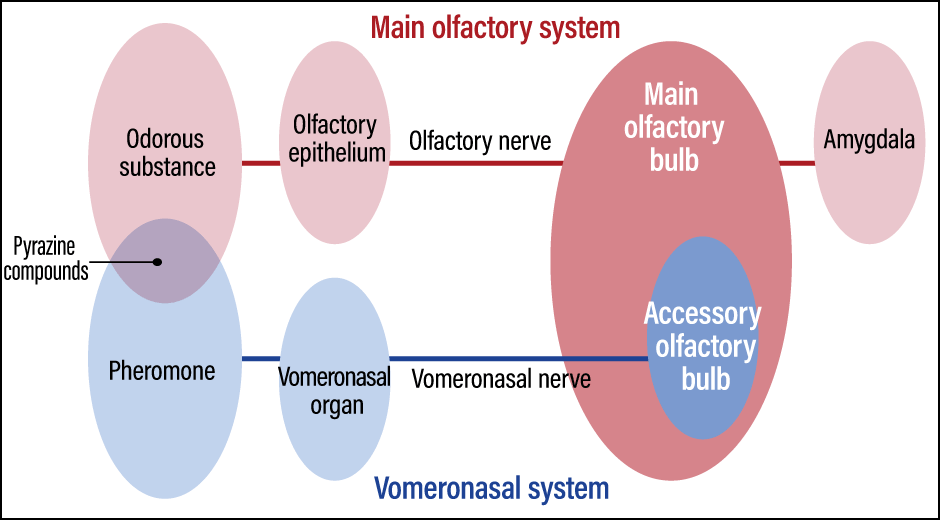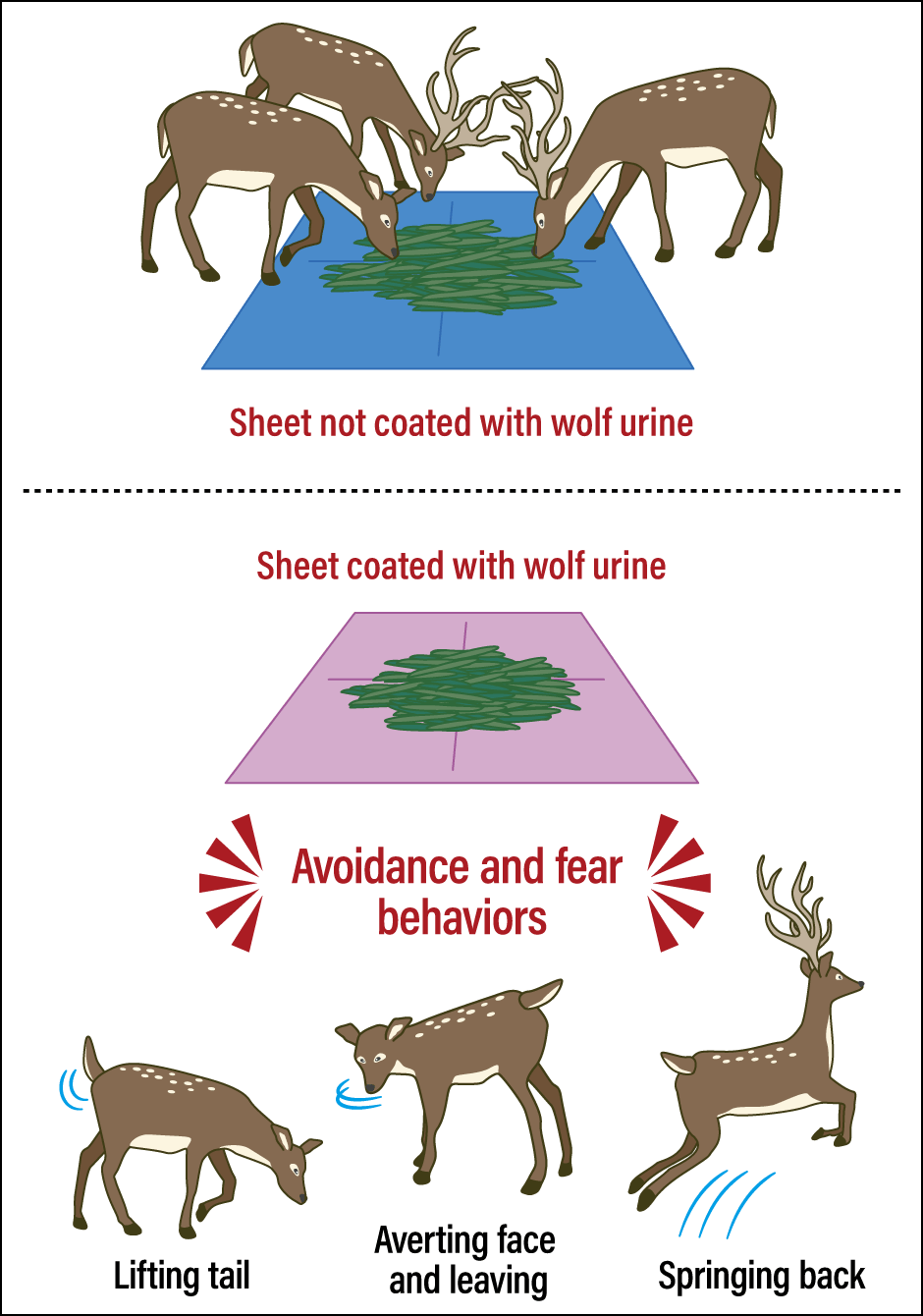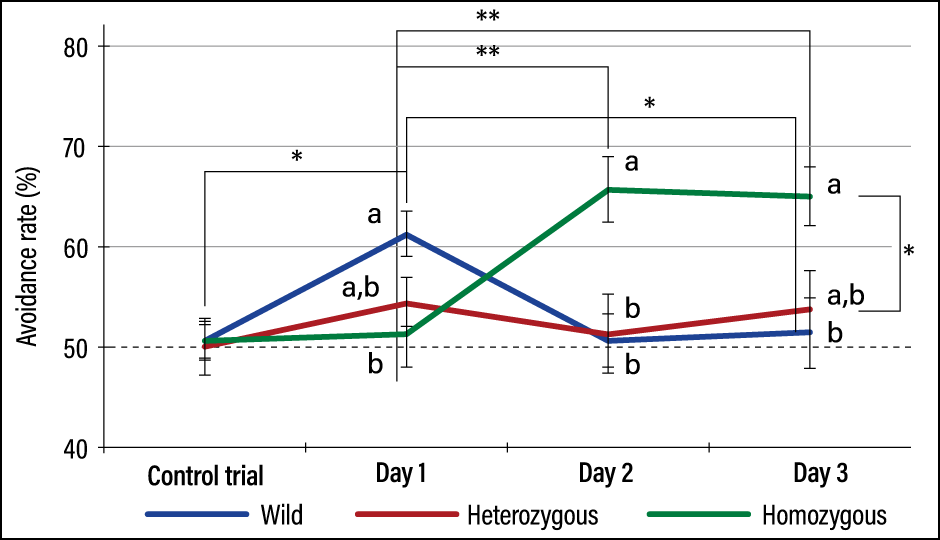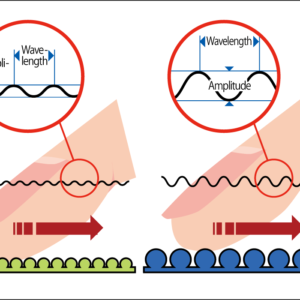The stimuli we receive via our sense of smell not only influence our mental state, making us feel pleasure or discomfort, but also sometimes even spur us to take some kind of action. Research into fear and avoidance behaviors resulting from odor components has already been applied in such areas as measures to prevent crop damage by wild animals, but it has emerged in recent years that olfactory receptors also influence human behavior. Also known as a happy hormone, oxytocin is a hormone that facilitates childbirth, but it also acts on receptors as a neurotransmitter that modulates various social behaviors and olfactory functions.
Special Feature 1 – The Science of Smell How smells influence our mental state and behavior through olfactory receptors
text by Toshiko Mogi
illustration by Rokuhisa Chino
Suppose that there is a drink such as barley tea, roasted green tea, or coffee in front of you. When you bring it to your mouth, its aromatic smell reaches you through the nasal cavity or the oral cavity via the nasopharynx, making the flavor even richer. Smell plays a major role in the satisfaction we gain from our enjoyment of something tasty via our gustatory sense.
The substance in wolf urine that induces fear
The origin of the pleasant aromas referred to in our example above is alkylpyrazine, one of a family of flavor compounds called pyrazines; alkylpyrazines are found in abundance in the foods that we humans find appetizing. However, different species demonstrate completely different reactions to exactly the same smell. When wild animals catch the odor of pyrazines in wolf urine, they experience the fear of becoming prey, rather than an appetite-whetting aroma.
Professor Kazumi Osada of the College of Bioresource Sciences at Nihon University brought this to light in an experiment. The study was conducted about 10 years ago, when he was working at a university in Hokkaido that had a problem with damage caused by Hokkaido deer (Cervus nippon yesoensis) feeding on plants.
“When the odor emitted by a predator evokes fear in a prey animal —— to put it another way, when it’s beneficial to the prey animal’s survival —— the odor is called a kairomone,” says Osada. “Ecologists have scientifically demonstrated that deer fear wolves. And it’s a well-known fact that many other small animals also fear wolves. This is why wolf urine is used as a means to prevent deer and small animals from causing damage to crops and other plants, by deterring the animals from getting close to them. However, its effects are variable. Accordingly, we conducted a joint study with neurophysiologists into the components of wolf urine and the reactions of animals when they smell them.”
As an expert in chemical analysis using gas chromatography (an analytical technique that involves separating a compound with a mixture of multiple components into its individual components), he worked on the relationship between odorous substances and experimental animals’ physical or psychological reactions and identifying the substances that cause such reactions. From the results, he discovered that pyrazine compounds in wolf urine are kairomones that induce a cross-species fear response in mice and rats. He himself observed how, when the experimental animals smelled the odor, they instantly demonstrated a vigilance response and, ultimately, freezing behaviors.
His research team undertook a study to identify the odor components that instantly induce fear behaviors and to shed light on the neural mechanisms involved.
An olfactory pathway that picks up pheromones
In humans, odorous substances are detected by the olfactory epithelium at the highest point of the nasal cavity; they then travel along the olfactory nerve as electrical signals and are transmitted to the olfactory bulb and olfactory cortex, where the odor is identified and the setting in which the odor was smelled is recalled. The processing of information to determine whether the smell is good or bad takes place in the amygdala. After that, if the smell is judged to be unpleasant, for example, the individual can be seen to demonstrate such behaviors as wrinkling their nose or trying to avoid the source of the smell.
Quadrupeds have another olfactory pathway —— the vomeronasal system —— in addition to this main olfactory system. The main olfactory system principally catches smells in the air, while the vomeronasal system picks up pheromones and the like in secretions. Just as in humans, the information is processed in the amygdala, leading to behaviors in response to the odor (Figure 1).

Figure 1. Odors sensed via two olfactory pathwaysQuadrupeds switch between the main olfactory system and the vomeronasal system for identifying odors. However, they use both in the case of odors that could be a matter of life or death, such as those of natural predators.
However, the instant freezing reaction is incredibly fast. What is the mechanism behind it?
“The amygdala has cells that induce certain behaviors; in the case of odors that are a matter of life or death, the switch that initiates action is turned on even before the brain has determined what the nature of the smell is. This is what’s thought to trigger instantaneous responses. While the amygdala is responsible for processing a variety of sensations, this triggering of an action before a judgment has been made is unique to olfaction.”
It had been thought that the time scale for information processing by the main olfactory system and the vomeronasal system differed completely. However, quadrupeds use both olfactory systems —— the main and the vomeronasal —— to pick up the odors of members of the opposite sex and natural predators, both of which are of particularly crucial significance from a biological perspective.
“When the experimental animals smelled pyrazine compounds, the odor stimulated both their main olfactory system and their vomeronasal system, and was received as information triggering fear, which activated such areas of the brain as the amygdala and the hypothalamus. From the results, it became clear that this causes innate fear behaviors and autonomic responses such as lowered skin temperature.”
Furthermore, the results suggested that, of the pyrazine compounds, those with an alkyl group consisting of three to four carbon atoms strongly provoked vigilance behaviors.
“Our research team also conducted experiments outdoors. With the cooperation of a Hokkaido deer farm, we placed in the feeding areas sheets equipped with a device that generated the odor of alkylpyrazine compounds. When we did so, most of the deer, regardless of sex, demonstrated avoidance behavior in the form of feeding in a location away from the ‘scary smell’ (Figure 2). While a few did approach the alkylpyrazine compounds, they were the strongest males, which were the leaders of the herd.”

Figure 2. Hokkaido deer experiment using wolf urineIn the outdoor experiment conducted by Osada and his team, sheets coated with wolf urine and sheets without the wolf urine were placed in feeding areas. The Hokkaido deer avoided the sheets bearing the odor of their natural predator and gathered at the feeding area with the sheet without the odor.
As is well known, the Japanese wolf (Canis lupus hodophilax) has been extinct for more than 100 years. This means, of course, that not only laboratory mice and rats, but also even Hokkaido deer have never actually encountered wolves. They have not learned the odor’s meaning, nor do they have any memory of it. Consequently, this avoidance is not induced by learning or remembering an odor. What causes such behavior?
“We think that the wild animals today might be the descendants of animals that fled from predators because they were able to sniff out kairomones in wolf urine. Information about which odors signal that an animal should protect itself could well be passed down at the genetic level to ensure survival.”
Civilization has placed humans at the very top of the food chain. This might be precisely why we experience odors that make wild animals feel afraid as aromatic smells signaling tastiness.
Smells also influence social behaviors
Smells are not only related to the food chain. The U.S. research institute where Osada once worked conducted a study into the determinants of attraction to the opposite sex. Men were attracted to visual appearance, while women were attracted to smell. So, one might say that women are not attracted to stinkers!
A topic in which he has been taking an interest in recent years is the olfaction and human sociability. The keyword here is oxytocin.
Secreted during childbirth to bring about uterine contractions, oxytocin also encourages milk ejection, with its secretion stimulated when a breastfeeding baby latches on to the nipple and begins to suck. In addition, oxytocin is secreted when an individual feels happy, such as when they lock eyes with someone they like or when interacting with a pet. As a result, it has come to be commonly described as a happy hormone.
“Oxytocin is produced in the supraoptic nucleus and paraventricular nucleus of the hypothalamus. Secreted by the brain’s posterior pituitary gland, which releases it as a hormone into the blood, oxytocin has been known for some time to have the aforementioned effects on childbirth and milk ejection. Recent research has begun to reveal that, aside from its functions as a hormone, oxytocin also acts as a signal in the brain that modulates a variety of social behaviors.”
This is also the most recent smell-related theme of his research.
For example, the inability to determine that the smell of a wolf’s urine indicates a predator would pose a direct risk to an animal’s life. Similarly, in human society, it is vital to be able to determine whether one can feel at ease with an individual or whether they are likely to be a dangerous enemy if one approaches them. One also needs to make various judgments in forming a society, including about building interpersonal relationships, as well as status and demeanor in society. However, there are people who have difficulty forming social relationships due to their inability to read the room and make such judgments. People with autism spectrum disorder (ASD) demonstrate an extreme tendency towards this inability.
“I’ve heard that abnormal olfactory behavior is a symptom of ASD. For example, some individuals might be unwilling to enter a room because they find it malodorous, even though others cannot smell anything, or they might find themselves constantly smelling the scent of apples. Smelling might cause more dramatic changes in our brains and bodies than we imagine.”
Oxytocin only begins to have an effect when it binds with a receptor. There are many oxytocin receptors in the amygdala and the olfactory bulb, both of which are involved in our sense of smell. So, we have oxytocin as a neurotransmitter, oxytocin receptors, and sites where many of those receptors are located. This led Osada to think that there might be some kind of relationship between the olfacation and social behaviors.
In fact, experimental animals with one (heterozygous) and both (homozygous) oxytocin receptor gene alleles knocked out are used in the ASD research.
“As ordinary experimental animals know their companions, they don’t sniff each other, but they do sniff any newcomers inserted into their group. However, experimental animals heterozygous or homozygous for the oxytocin receptor gene don’t exhibit such context-dependent behavior. In light of this fact, I began to undertake research into oxytocin receptors from the perspective of olfactory behavioral anomalies.”
The research team constructed a Y-maze and conducted an experiment to compare the behavioral responses of homozygous (oxytocin receptor gene-deficient), heterozygous, and wild-type mice when confronted with an unpleasant odor (butyric acid: an odor reminiscent of putrefying food, stinky feet, and ripe ginkgo nuts) (Figures 3-1 and 3-2).
 Osada K, Ohta T, Takai R, Miyazono S, Kashiwayanagi M, Hidema S, Nishimori K.
Osada K, Ohta T, Takai R, Miyazono S, Kashiwayanagi M, Hidema S, Nishimori K. Oxytocin receptor signaling contributes to olfactory avoidance behavior induced by
an unpleasant odorant. Biol Open. 2018 Sep 26;7(9):bio029140.
Figure 3-1. Changes in the avoidance rate over timeWild-type mice and mice that were heterozygous and homozygous for the oxytocin receptor gene were placed in a Y-maze and a comparison was made of their avoidance rate in fleeing from the arm containing an unpleasant odor to the arm containing odorless air.
 Osada K, Ohta T, Takai R, Miyazono S, Kashiwayanagi M, Hidema S, Nishimori K. Oxytocin receptor signaling contributes to olfactory avoidance behavior induced by an unpleasant odorant. Biol Open. 2018 Sep 26;7(9):bio029140.
Osada K, Ohta T, Takai R, Miyazono S, Kashiwayanagi M, Hidema S, Nishimori K. Oxytocin receptor signaling contributes to olfactory avoidance behavior induced by an unpleasant odorant. Biol Open. 2018 Sep 26;7(9):bio029140.
Figure 3-2. Comparison of time changes in avoidance rates between male and female miceThe wild-type mice initially sought to avoid the unpleasant odor of butyric acid when first confronted with it, but their vigilance behaviors diminished on the second and subsequent occasions. Avoidance and vigilance were observed in some of the mice that were homozygous and heterozygous for the oxytocin receptor gene, but not in others. In all cases, there was no difference between the sexes.
The experiment involved placing a sheet coated with butyric acid somewhere in the Y-maze once a day, repeated for three days. On the first day, the wild-type mice with oxytocin receptors demonstrated avoidance behavior, turning their faces away from the smell as if to say, “That stinks!” However, when they encountered the same smell again on the second day, they no longer avoided it, perhaps because they had realized it was not especially harmful. Thus, they demonstrated acclimation to the smell.
“The first response was an instinctive avoidance of danger, but vigilance subsequently eased. This is a completely normal reaction.”
However, experimental animals heterozygous or homozygous for the oxytocin receptor gene do not demonstrate the initial instinctive avoidance of danger. Or perhaps, they cannot do so. He says they could not tell whether vigilance eased thereafter.
Playing a key role in regulating olfactory behavior
“Oxytocin receptors are thought to play an important role in regulating olfactory behavior in the absence of a social context.”
This study was published in 2018 in Biology Open, an online open-access journal published by The Company of Biologists.
It goes without saying that Osada is interested in the quantity of oxytocin secreted, but he is even more interested in changes in the level of expression of oxytocin receptor genes.
“This is because there are many oxytocin receptors in the amygdala and the olfactory bulb, both of which are involved in our sense of smell. The receptors are located in various places, but some reports suggest that their distribution is most numerous around the olfactory bulb interneurons.”
Oxytocin is a neuromodulator conveying odors. There are many oxytocin receptors at sites that judge whether a smell is pleasant or unpleasant and sites that transmit odors. Consequently, it is thought that oxytocin might act on the receptors to control the emotions evoked by our sense of smell and olfactory functions.
In 2005, researchers from the University of Zurich Institute for Empirical Research in Economics in Switzerland published an article stating that the intranasal administration of an oxytocin spray to healthy adult males increases their trust in others. Within Japan, one research team is currently seeking to apply for approval of an intranasal oxytocin spray as the world’s first therapeutic drug for the core symptoms of ASD. Given this situation, what direction is Osada pursuing in his oxytocin research?
“I hope we might be able to improve symptoms using food aromas.”
However, he says it is unlikely to be a simple matter of oxytocin secretion increasing in response to smelling these scents.
“This is because the glands that secrete oxytocin are themselves quite robust. Instead, based on the hypothesis that, where oxytocin receptors are depleted, we can increase their number with food aromas, we’re working on research in the hope that continuously smelling food aromas might improve abnormal olfactory behaviors.”
He is currently preparing to publish the findings from his latest study. Interest and expectations alike are set to grow in regard to the question of how food aromas contribute to building the sociability that builds ties between people.


















